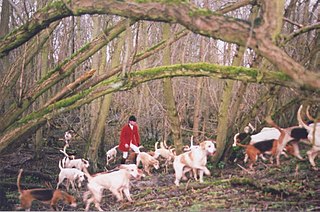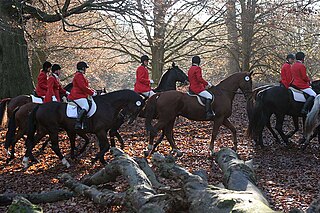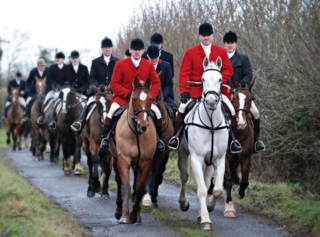 W
WThe Airedale Beagles is a beagle pack founded in 1891.
 W
WThe Basset Hound is a short-legged breed of dog in the hound family. The Basset is a scent hound that was originally bred for the purpose of hunting hare. Their sense of smell and ability to ground-scent is second only to the Bloodhound.
 W
WThe beagle is a breed of small scent hound, similar in appearance to the much larger foxhound. The beagle was developed primarily for hunting hare (beagling). Possessing a great sense of smell and superior tracking instincts, the beagle is the primary breed used as a detection dog for prohibited agricultural imports and foodstuffs in quarantine around the world. The beagle is intelligent. It is a popular pet due to its size, good temper, and a lack of inherited health problems.
 W
WThis is a list of beagle, harrier and basset hounds packs of the United Kingdom, registered with either the Association of Masters of Harriers and Beagles, or the Masters of Basset Hounds Association. Prior to the 2004 Hunting Act, these packs either hunted hare, or in the case of some harrier packs, foxes. Hunts are now obliged to either practice trail hunting, hunt rabbits or follow other exemptions set out in the Act.
 W
WBeagling is the hunting mainly of hares and also rabbits, but definitely not foxes, by beagles by scent. A beagle pack is usually followed on foot, but in a few cases mounted. Beagling is often enjoyed by 'retired' fox hunters who have either sustained too many injuries or lost the agility to ride horseback, or who enjoy the outdoors and the camaraderie of the hunt. It is also traditionally a way for young men and women to learn how to handle hounds on a smaller scale before they go on to hunt with foxhounds.
 W
WThe Bloodhound is a large scent hound, originally bred for hunting deer, wild boar and, since the Middle Ages, for tracking people. Believed to be descended from hounds once kept at the Abbey of Saint-Hubert, Belgium, it is known to French speakers as le chien de Saint-Hubert.
 W
WThe Burns Inquiry was a Government committee set up to examine the facts in the debate in the United Kingdom about hunting with hounds.
 W
WCoon hunting or raccoon hunting is the practice of hunting raccoons, most often for their meat and fur. It is almost always done with specially bred dogs called coonhounds, of which there are six breeds, and is most commonly associated with rural life in the Southern United States. Coon hunting is also popular in the rural Midwest. Most coon hunts take place at night, with the dogs being turned loose, trailing and putting the raccoon up a tree without human assistance. Once the raccoon is in the tree, with the dog at the base, it is referred to as "treed", with "treeing" being the active verb form.
 W
WDrag hunting, or draghunting, is a form of equestrian sport, where mounted riders hunt the trail of an artificially laid scent with hounds.
 W
WA field hunter, or a fox hunter, is a type of horse used in the hunt field for fox hunting and stag hunting.
 W
WFox hunting is an activity involving the tracking, chase and, if caught, the killing of a fox, traditionally a red fox, by trained foxhounds or other scent hounds. A group of unarmed followers, led by a "master of foxhounds", follow the hounds on foot or on horseback. In Australia, the term also refers to the hunting of foxes with firearms, similar to deer hunting.
 W
WA foxhound is a type of large hunting hound bred for strong hunting instincts, a keen sense of smell, their bark, energy, drive, and speed. In fox hunting, the foxhound's namesake, packs of foxhounds track quarry, followed—usually on horseback—by the hunters, sometimes for several miles at a stretch; moreover, foxhounds also sometimes guard sheep and houses.
 W
WA hound is a type of hunting dog used by hunters to track or chase prey.
 W
WThe Hunting Act 2004 is an Act of the Parliament of the United Kingdom which bans the hunting of wild mammals with dogs in England and Wales; the Act does not cover the use of dogs in the process of flushing out an unidentified wild mammal, nor does it affect drag hunting, where hounds are trained to follow an artificial scent.
 W
WThe Otterhound is a British dog breed. It is a scent hound and is currently recognised by the Kennel Club as a Vulnerable Native Breed with around 600 animals worldwide.
 W
WThe Protection of Wild Mammals (Scotland) Act is an Act of the Scottish Parliament passed in February 2002, making Scotland the first part of the United Kingdom to ban traditional fox hunting and hare coursing.
 W
WThe Royal Rock Beagles was a pack of beagles founded at Rock Ferry in 1845. The pack was used to hunt hare in the Wirrall and subsequently in Wales as the character of the Cheshire countryside changed. It was for a long time the oldest beagle pack in the UK but ceased to hunt in 2015.
 W
WScent hounds are a type of hound that primarily hunts by scent rather than sight. These breeds are hunting dogs and are generally regarded as having some of the most sensitive noses among dogs. Scent hounds specialize in following scent or smells. Most of them tend to have long, drooping ears and large nasal cavities to enhance smell sensitivity. They relatively need to have high endurance to be able to keep track of scent over long distances and rough terrain. It is believed that they were originally bred by the Celts.
 W
WTally-ho is the traditional cry made by the huntsman to tell others the quarry has been sighted. It may also be used with directions, including "away" and "back". It is also used in Britain as a light-hearted way of saying goodbye, much like the word "cheerio".